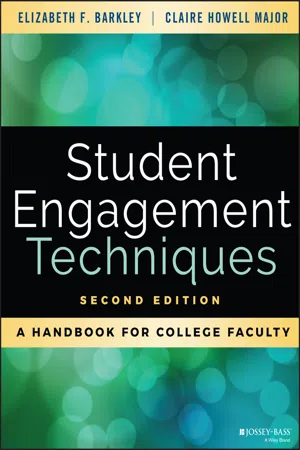
Student Engagement Techniques
A Handbook for College Faculty
Elizabeth F. Barkley, Claire H. Major
- English
- ePUB (adapté aux mobiles)
- Disponible sur iOS et Android
Student Engagement Techniques
A Handbook for College Faculty
Elizabeth F. Barkley, Claire H. Major
À propos de ce livre
Practical Strategies and Winning Techniques to Engage and Enhance Student Learning
The revised and updated second edition of Student Engagement Techniques is a much-needed guide to engaging today's information-overloaded students. The book is a comprehensive resource that offers college teachers a dynamic model for engaging students and includes over one hundred tips, strategies, and techniques that have been proven to help teachers across all disciplines motivate and connect with their students.
This edition will provide a deeper understanding of what student engagement is, demonstrate new strategies for engaging students, uncover implementation strategies for engaging students in online learning environments, and provide new examples on how to implement these techniques into STEM fields.
"Student Engagement Techniques is among a handful of books—several of which are in this series!—designed specifically to help instructors, regardless of experience, create the conditions that make meaningful, engaged learning not just possible but highly probable." — Michael Palmer, Ph.D., Director, Center for Teaching Excellence, Professor, General Faculty, University of Virginia
"This practical guide to motivating and engaging students reads like a quite enjoyable series of conversations held over coffee with skilled colleagues. It has been met with delight from every faculty member and graduate instructor that we've shared the book with!" — Megan L. Mittelstadt, Ph.D., Director, Center for Teaching and Learning, The University of Georgia
"Student Engagement Techniques belongs in the hands of 21st century instructors and faculty developers alike. Its research-based, specific, yet broadly applicable strategies can increase student engagement in face-to-face and online courses in any discipline." — Jeanine A. Irons, Ph.D., Faculty Developer for Diversity, Equity, and Inclusion, Center for Teaching and Learning Excellence, Syracuse University
"This book is an essential resource for faculty seeking to better engage with their students. Anyone seeking a clear, research-based, and actionable guide needs a copy of Student Engagement Techniques on their shelf!" — Michael S. Harris, Ed.D., Associate Professor of Higher Education, Director, Center for Teaching Excellence, Southern Methodist University
Foire aux questions
Informations
Part One
A Conceptual Framework for Understanding Student Engagement
Chapter 1
What Does “Student Engagement” Mean?
About the Term
Perhaps the strongest conclusion that can be made is the least surprising. Simply put, the greater the student's involvement or engagement in academic work or in the academic experience of college, the greater his or her level of knowledge acquisition and general cognitive development. (p. 848)
The first is the amount of time and effort students put into their studies and other activities that lead to the experiences and outcomes that constitute student success. The second is the ways the institution allocates resources and organizes learning opportunities and services to induce students to participate in and benefit from such activities. (p. 9)
Within the community of academic practitioners, engagement by students is most commonly interpreted in relation to the psychology of individual learning: the degree at which students engage with their studies in terms of motivation, the depth of their intellectual perception or simply studiousness. Engaged students are viewed as taking ownership for their own learning, working together with [faculty] on ensuring academic success and accepting the role of engaged and willing apprentice to an academic master. (p. 78)